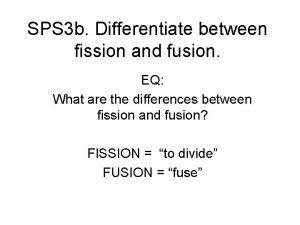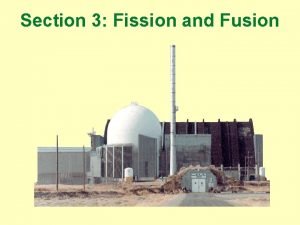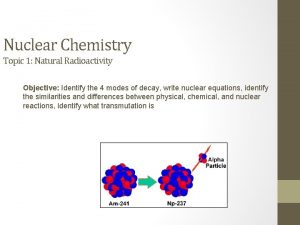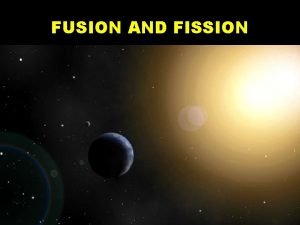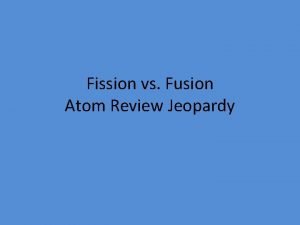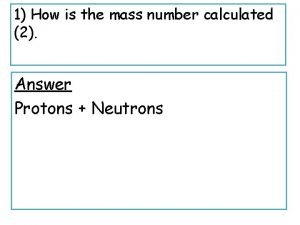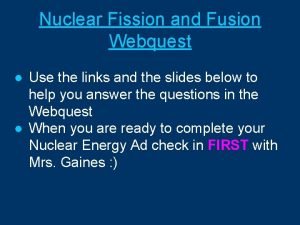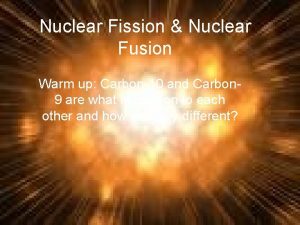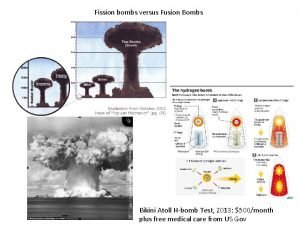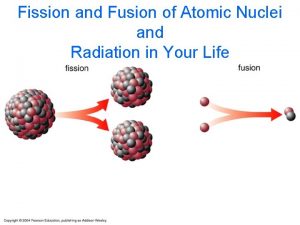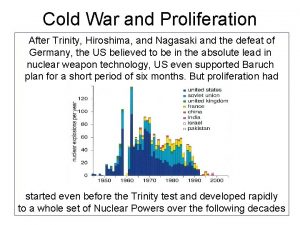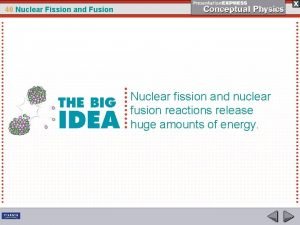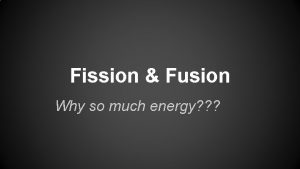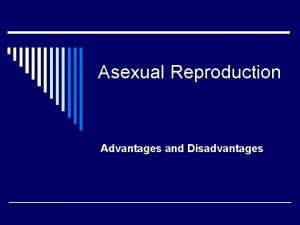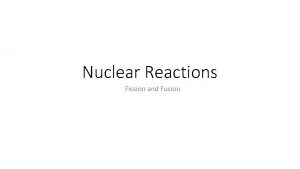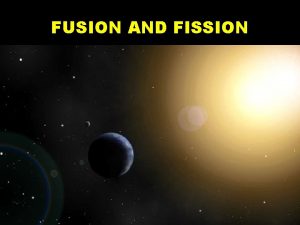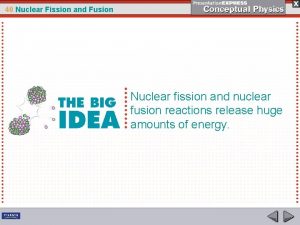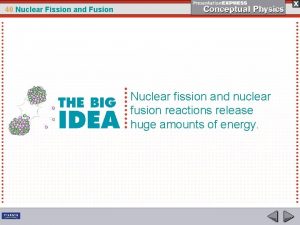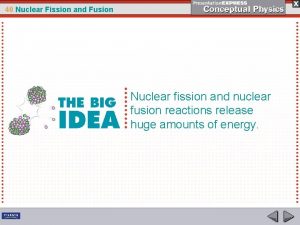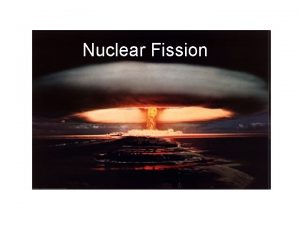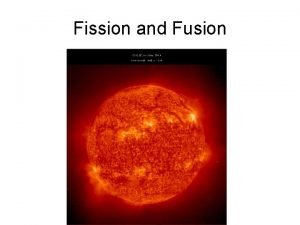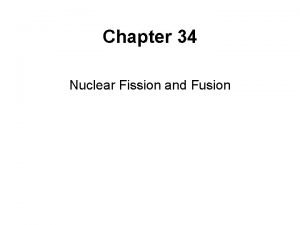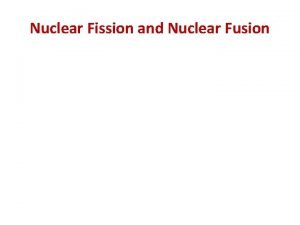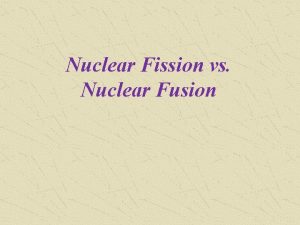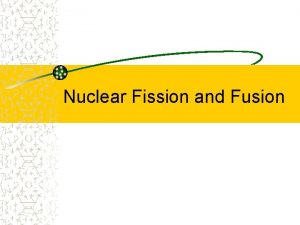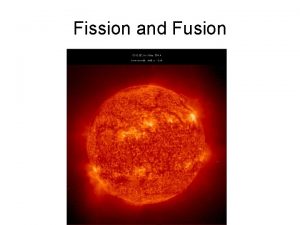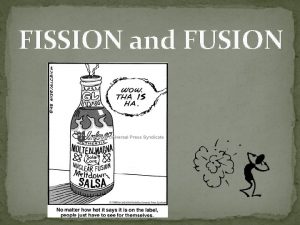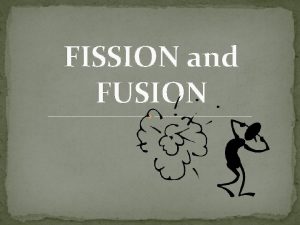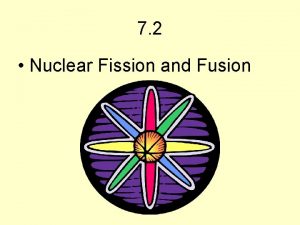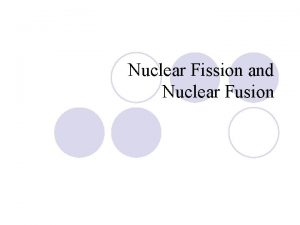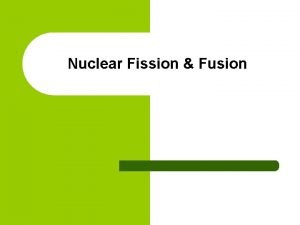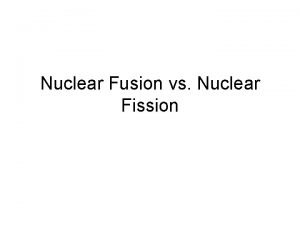Section 3 Fission and Fusion Fission is the























- Slides: 23

Section 3: Fission and Fusion

Fission is the splitting of an atomic nucleus into two smaller parts. In nuclear fission, tremendous amounts of energy can be produced from very small amounts of mass. E = mc 2

Fission The fission of uranium-235 yields smaller nuclei, neutrons, and energy. Neutron

Fission The fission of uranium-235 yields smaller nuclei, neutrons, and energy. Neutron

Fission The fission of uranium-235 yields smaller nuclei, neutrons, and energy. Neutron

Fission The fission of uranium-235 yields smaller nuclei, neutrons, and energy. Neutron Energy

Fission Triggering a Chain Reaction • In a chain reaction, neutrons released during the splitting of an initial nucleus trigger a series of nuclear fissions.

Fission Nuclear Fission of Uranium-235

Fission

Fission In an uncontrolled chain reaction, all of the released neutrons are free to cause other fissions. • The result is a fast, intense release of energy. • Nuclear weapons are designed to produce uncontrolled chain reactions.

Fission In a controlled chain reaction, some of the neutrons are absorbed by other materials. The heat from controlled chain reactions can be used to generate electrical energy, which doesn’t emit pollutants.

Nuclear Power Plant

Fission Unfortunately, a product of controlled chain reactions is radioactive waste. A crane lowers drums of radioactive waste into a landfill in Hanford, Washington.


Fusion is a process in which the nuclei of two atoms combine to form a larger nucleus. A small fraction of the reactant mass is converted into energy. Fusion produces more energy than fission!!

Fusion

Fusion The sun and other stars are powered by the fusion of hydrogen into helium. • requires extremely high temperatures (10 to 100 million o. C). • Hydrogen must be in the plasma state (difficult to contain)

Fusion The Tokamak Fusion Test Reactor at the Princeton Plasma Physics Laboratory was one of the very few fusion reactors that have been built.

Fission vs Fusion F I S S I O N Fission • 235 U is limited • meltdown risk • radioactive waste • less energy vs. Fusion F U S I O N • Hydrogen is abundant • no meltdown risk • harmless product • not yet sustainable

Assessment Questions 1. Which of the following statements about nuclear fission is false? a. Fission is the splitting of a nucleus into two smaller parts. b. Fission produces tremendous amounts of energy from a small mass. c. Mass is conserved during nuclear fission. d. Fission does not always yield the same products.

Assessment Questions 1. Which of the following statements about nuclear fission is false? a. Fission is the splitting of a nucleus into two smaller parts. b. Fission produces tremendous amounts of energy from a small mass. c. Mass is conserved during nuclear fission. d. Fission does not always yield the same products. ANS: C

Assessment Questions 2. Why has nuclear fusion not been used to produce power on Earth. a. Fusion only occurs in high temperature plasmas, which cannot yet be controlled. b. Nuclear fusion requires deuterium, which is not available on Earth. c. Fusion does not produce enough energy to justify its use. d. Scientists do not yet know how to start a fusion reaction.

Assessment Questions 2. Why has nuclear fusion not been used to produce power on Earth. a. Fusion only occurs in high temperature plasmas, which cannot yet be controlled. b. Nuclear fusion requires deuterium, which is not available on Earth. c. Fusion does not produce enough energy to justify its use. d. Scientists do not yet know how to start a fusion reaction. ANS: A
 Fission or fusion
Fission or fusion Natural vs artificial radioactivity
Natural vs artificial radioactivity Fusion vs fission
Fusion vs fission Nuclear fission and fusion similarities
Nuclear fission and fusion similarities Is the sun fusion or fission
Is the sun fusion or fission Fission vs fusion
Fission vs fusion Fission and fusion similarities
Fission and fusion similarities Nuclear fission and fusion
Nuclear fission and fusion Who discovered radioactivity
Who discovered radioactivity Fission vs fusion
Fission vs fusion Fission vs fusion nuclear
Fission vs fusion nuclear Fission vs fusion
Fission vs fusion Fission vs fusion
Fission vs fusion Fusion or fission
Fusion or fission Disadvantages of binary fission
Disadvantages of binary fission Hát kết hợp bộ gõ cơ thể
Hát kết hợp bộ gõ cơ thể Lp html
Lp html Bổ thể
Bổ thể Tỉ lệ cơ thể trẻ em
Tỉ lệ cơ thể trẻ em Chó sói
Chó sói Chụp phim tư thế worms-breton
Chụp phim tư thế worms-breton Chúa sống lại
Chúa sống lại Môn thể thao bắt đầu bằng từ chạy
Môn thể thao bắt đầu bằng từ chạy Thế nào là hệ số cao nhất
Thế nào là hệ số cao nhất
